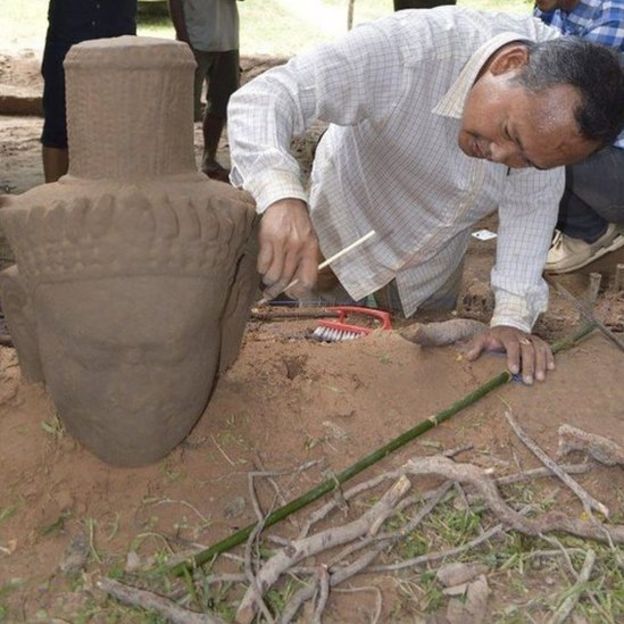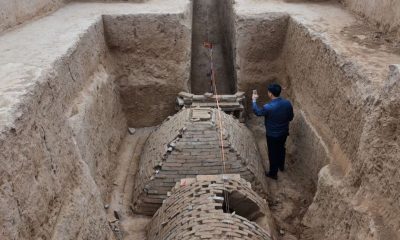Feature
Ancient statue unearthed at Cambodia Angkor Wat

Cambodia: After too many centuries passed away and many cities have started and collapsed but to then also if any object found safely inside earth would be surprised. A team of archaeologists were happy, as they find pottery shards when they excavate a site in Angkor Archaeological Park in Cambodia.
On last Saturday site on Angkor Archaeologists park seemed like something that happens only in the movies. On last Saturday as the team was on excavation in Siem Reap province, a team of archaeologists found a 1.9 meter statue weighing about 200 kg at an 800-year-old site in Angkor Park.
The archaeology team holds a religious ceremony on Sunday to ask the spirit protecting the site permission to move the statue they unearthed the previous day to the Preah Sihanouk Museum in Siem Reap province.
An archaeologist with Apsara Authority said “We were very surprised to find this. The sandstone statue is missing its feet and parts of its legs. Had it been whole, it would have stood at least 2.1 meters, he said. In the image of a guard, it would have stood on the grounds of a hospital that was located next to the northern entrance of Angkor Thom, the walled city of King Jayavarman VII.
The excavation began last Friday and is meant to last about 12 days. The hospital is one of the 102 that the 12th century king is believed to have built throughout his Angkorian empire, said Tan Boun Suy, deputy director-general for the Apsara Authority.
“Jayavarman VII’s reign was truly remarkable in terms of social programs,” he said. “The hospital consisted of wooden buildings and a chapel erected in stones. What is left is the chapel, as wooden structures have long disappeared.”
Archaeologists further added, If the excavation unearths other objects of the time, it would provide useful information on the life and activities in those hospitals and also the lives of ordinary people of the era, of which very little is known.
For this excavation, the Apsara Authority retained Rethy Chhem as an adviser. A university professor and radiologist who heads the Cambodia Development Resource Institute, a Phnom Penh think tank, Dr. Chhem is also a historian and the authority on Angkorian-era hospitals and medicine, Mr. Boun Suy said.
Archaeologists made a grid to draw the statue yesterday before moving it. Moreover, Dr. Chhem initiated and led the 2006 excavation of a hospital built during the same era near the western gate of Angkor Thom alongside French archaeologist Christophe Pottier.
“There are four hospitals identified at the four cardinal points of Angkor Thom,” Dr. Chhem said last Friday. “They were identified by French archaeologists about 100 years ago, but had never been excavated.”
Many statues of the Buddha were destroyed during the reign of Jayavarman VIII in the mid-13th century in his effort to restore Brahmanism in the country, and most of those that remained were looted, although some were buried for their protection.
Dr. Chhem and the excavation team never dreamed of finding one of the hospital’s major statues on the second day of excavation. And yesterday, the team kept making discoveries: They found a piece of another statue, Mr. Sokrithy said. “We also found much evidence of wooden structures such as roof tiles and ceramics.”
The excavation is conducted by the Apsara Authority in cooperation with the Institute of Southeast Asian Studies’ Yusof Ishak Institute in Singapore. As part of a training program, 10 students from Asian countries, the U.S. and Australia are taking part in the excavation, Mr. Sokrithy said.
Entertainment
Meghalaya Reserves Legalized Gambling and Sports Betting for Tourists

The State Scores Extra High on Gaming-Friendly Industry Index
Meghalaya scored 92.85 out of 100 possible points in a Gaming Industry Index and proved to be India’s most gaming-friendly state following its recent profound legislation changes over the field allowing land-based and online gaming, including games of chance, under a licensing regime.
The index by the UK India Business Council (UKIBC) uses a scale of 0 to 100 to measure the level of legalisation on gambling and betting achieved by a state based on the scores over a set of seven different games – lottery, horse racing, betting on sports, poker, rummy, casino and fantasy sports
Starting from February last year, Meghalaya became the third state in India’s northeast to legalise gambling and betting after Sikkim and Nagaland. After consultations with the UKIBC, the state proceeded with the adoption of the Meghalaya Regulation of Gaming Act, 2021 and the nullification of the Meghalaya Prevention of Gambling Act, 1970. Subsequently in December, the Meghalaya Regulation of Gaming Rules, 2021 were notified and came into force.
All for the Tourists
The move to legalise and license various forms of offline and online betting and gambling in Meghalaya is aimed at boosting tourism and creating jobs, and altogether raising taxation revenues for the northeastern state. At the same time, the opportunities to bet and gamble legally will be reserved only for tourists and visitors.
“We came out with a Gaming Act and subsequently framed the Regulation of Gaming Rules, 2021. The government will accordingly issue licenses to operate games of skill and chance, both online and offline,” said James P. K. Sangma, Meghalaya State Law and Taxation Minister speaking in the capital city of Shillong. “But the legalized gambling and gaming will only be for tourists and not residents of Meghalaya,” he continued.
To be allowed to play, tourists and people visiting the state for work or business purposes will have to prove their non-resident status by presenting appropriate documents, in a process similar to a bank KYC (Know Your Customer) procedure.
Meghalaya Reaches Out to a Vast Market
With 140 millions of people in India estimated to bet regularly on sports, and a total of 370 million desi bettors around prominent sporting events, as per data from one of the latest reports by Esse N Videri, Meghalaya is set to reach out and take a piece of a vast market.
Estimates on the financial value of India’s sports betting market, combined across all types of offline channels and online sports and cricket predictions and betting platforms, speak about amounts between $130 and $150 billion (roughly between ₹9.7 and ₹11.5 lakh crore).
Andhra Pradesh, Telangana and Delhi are shown to deliver the highest number of bettors and Meghalaya can count on substantial tourists flow from their betting circles. The sports betting communities of Karnataka, Maharashtra, Uttar Pradesh and Haryana are also not to be underestimated.
Among the sports, cricket is most popular, registering 68 percent of the total bet count analyzed by Esse N Videri. Football takes second position with 11 percent of the bets, followed by betting on FIFA at 7 percent and on eCricket at 5 percent. The last position in the Top 5 of popular sports for betting in India is taken by tennis with 3 percent of the bet count.
Local Citizens will Still have Their Teer Betting
Meghalaya residents will still be permitted to participate in teer betting over arrow-shooting results. Teer is a traditional method of gambling, somewhat similar to a lottery draw, and held under the rules of the Meghalaya Regulation of the Game of Arrow Shooting and the Sale of Teer Tickets Act, 2018.
Teer includes bettors wagering on the number of arrows that reach the target which is placed about 50 meters away from a team of 20 archers positioned in a semicircle.
The archers shoot volleys of arrows at the target for ten minutes, and players place their bets choosing a number between 0 and 99 trying to guess the last two digits of the number of arrows that successfully pierce the target.
If, for example, the number of hits is 256, anyone who has bet on 56 wins an amount eight times bigger than their wager.
















